Chapter VII
Feeding and Feeds
Next to breeding and housing, the feeding of fowls is perhaps the most important essential in poultry raising. Poultry keepers, as a rule, do not realize the importance of good feed. Others place too much responsibility upon the feed and feeding. Let it be remembered that no amount and no quality of feed or anything else will make all hens lay or all poultry profitable. The factor of individuality must be considered. Some hens will lay 150 to 200 eggs in a year and others treated the same will not lay an egg. On the other hand, no amount of good feeding will make up for lack of good breeding or good housing.
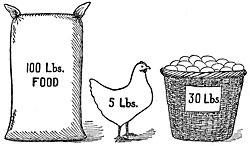
Raw material, egg machine and finished product. The Oregon experiment station thus graphically teaches what a utility fowl does.
|
It is now recognized that food affects the quality of eggs. While it is doubtful if the hen could lay eggs wholly unfit for food, it has been shown by experiment that the quality of eggs can be injured, especially in flavor. Onions and fish have both been found to give an unpleasant flavor to eggs when fed to excess; so will beef scrap. Doubtless other feeds will do the same. It is not necessary that these feeds should be discarded, because when fed in normal amounts they will not perceptibly flavor the eggs. When hens have been starved for want of green food or animal food and then get a chance to eat to excess they will produce unpleasant results in the eggs. This shows that hens put into the eggs what they find in the feed. Hence the importance of supplying good, wholesome feed at all times.
Skillful feeders can vary the shade of yellow in the yolk of the egg by the feeding, but not alter the color of the shell. Dried alfalfa has been found to produce eggs with good yolk color. Sugar beets produce a pale tint. Kale makes a good yellow. Some people hold that yellow corn will color the yolk, but this has not been credibly verified. Pale yolks indicate that hens are not getting sufficient green feed. Probably clover, vetch, rape, grass and other green feeds will all produce yellow yolks.
Feed Affects Quantity of Eggs
There is no question that food affects the quantity of eggs. Good feeding will help to make good hens productive. In one instance a pen of four fowls laid over 800 eggs in one year. Another pen of full sisters, but fed differently, laid only about 530.
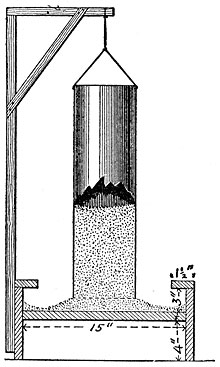
Stove pipe hopper. Simple and convenient. May be hung from ceiling or as shown.
|
The difference in the feeding is accountable. It has also been shown that feeding will influence the size of the eggs. Neither the hens nor the breed are responsible.
A correct study of feeds and feeding must necessarily include cost and profit as well as composition of the feeds themselves. Though a ration may give good results in a yield of eggs, it may not be profitable because of its high cost. It is not essential to use any special brand or kind of feed, nor is it necessary to pay more for a feed than for the food of the home table. Many rations are impracticable, simply because they are too costly. Knowledge of poultry feeding has not gone far enough for anyone to say that certain results can be secured from certain feeds or rations, yet much valuable information has been secured by experimental feeding, and through the experience of practical poultry keepers. The chemist classifies the composition of feeds into protein, fat, carbohydrates and ash constituents. These are all contained in all feeds, but in varying proportion. The chemist also tells us that eggs contain the same constituents, but with a larger proportion of protein. Eggs are more valuable as a market commodity than grain. A pound may be worth from 10 to 25 cents in the market, whereas a pound of wheat would rarely exceed two cents in market value. The hen may convert this comparatively cheap wheat into a product of much higher value. For this reason she may be looked upon as a manufactory. Still she can utilize at least a pound of water for every pound of wheat she puts into the eggs, and thus the poultryman can sell water for a good price.
What Hens Put in Eggs
It must be remembered that the hen puts into the egg what the poultryman gives her. No one can say definitely what kind or combination of feed will give best results in good yield. The chemist does not tell and practical feeders do not. Nothing but experimental work can solve this problem. It is known, however, that eggs have a certain composition and to produce them the hen must have certain elements in her feed. The composition of the egg varies scarcely at all. The hen must, therefore, have the proper feeds to supply the demand of the egg. If she cannot get these she will stop laying. If fed exclusively on wheat she may eat a quarter of a pound a day. Of this she will probably consume three ounces to supply the demands of her body, thus leaving 1 ounce with which to make eggs. In this ounce there is about one-tenth of an ounce of protein. Supposing that this were all digested -- which is never the case -- there will not be enough protein to make an egg, because each egg contains about one-quarter ounce of protein. A hen so fed would require two or three days to secure enough protein to make an egg.
Eggs contain also one-quarter ounce of ash, mostly in the shell. An ounce of wheat contains less than one-tenth as much lime and other ash constituents as the egg contains. Eggs also contain fat, less than one-quarter of an ounce; wheat contains three-quarters of an ounce. When fed as above hens would not get egg constituents in proper proportions to make an egg a day. It is just as poor economy to feed corn or any other feed exclusively. The rations must be balanced. If left to herself the hen would secure what she needs if such raw material were available.
The following suggestions will prove helpful: The hen first supplies the needs of her body. This demands constant rebuilding because of the continual wearing out or breaking down of animal tissue. The poultryman must therefore feed more than enough to supply this waste. He must feed a growing ration to the chicks and other young fowls. He must compound rations to insure health and vitality and then supply enough raw material of the various kinds for the hen to make eggs. Eggs are made from surplus food. After the hen has supplied her body wastes, she may devote the balance to egg production. It is therefore poor economy to feed just enough to keep the hen in health and vigor. Heavy feeding, however, does not necessarily mean heavy egg yield. While the heavy layer must consume abundant food, the manner of feeding and the kind of feed must be reckoned because the efficiency of feed depends largely upon the kind of the feed itself and the skill of feeding.
Poultry feeds contain various quantities of protein, carbohydrates, fat and water. The water is frequently overlooked by the feeder. Even wheat contains about 10%; clover and alfalfa 75% and in skimmed milk there is about 90%. No poultryman should pay more for water in the feed than as water from his well or spring. Grain feeds are also deficient in ash. Hence the hen must secure grit, oyster shell, etc., to supply this lack. The ash, therefore, need not be considered of high value because of its cheap source. Carbohydrates and fat furnish the fuel necessary to keep the body warm. It is necessary for the hen to be warm in order to produce eggs. Unless warm and energetic she cannot digest the food as well.
As a rule poultry feeds contain larger percentages of carbohydrates and fat than are required for best results in egg production. Usually they are deficient in protein, which is the most valuable constituent. This substance makes the lean meat and the muscle and a large percentage of the egg, especially the white. The value of the feed must be determined largely by the percentage of protein it contains. A high price, therefore, should not be paid for feed unless this has a high percentage of protein. In general feeds may be considered expensive or cheap in proportion as they contain small or large proportions of protein.
In studying feeds digestibility must be considered. Composition does not necessarily indicate the true value of feeds, because these may not be digestible. The digestibility of poultry feeds has not been studied sufficiently. There are considerable difficulties in the way. Probably, however, these studies will be made in the future and better systems of feeding will be worked out. So far the chemical composition of feeds and the analogies between poultry feeding and animal feeding are the only guides for working out balanced rations for poultry.
In the table given below Prof. James Dryden, of Oregon, shows the composition of feeds commonly given to poultry.
Nutritive Ratio
What is called the nutritive ratio is the proportion existing between the content of protein and that of fat and heat-producing constituents. To produce eggs, what is called a narrow nutritive ratio should be fed; that is, a proportion of one part protein to four or five of carbohydrates and fat. In figuring the ratio the fat is multiplied by 2-1/4, because 1 pound is estimated to be equivalent to that amount of carbohydrates. It must be remembered, however, that a nutritive ratio in itself does not necessarily indicate the true value of a ration. Palatability, digestibility and other factors must be reckoned with. Even a proper ratio does not guarantee a good egg yield. The kinds of feed must be considered, and the feeder must be guided by results that indicate the value of the different feeds.
Individual Feeds
Wheat is more widely used than any other cereal throughout the country for poultry feeding, because it is safer than most other grain feeds and is relished better by the fowls. Its nearest competitor is corn. Which of these should be fed depends largely upon price. If fed wheat alone, hens would probably lay better than if given corn alone, because the composition of wheat is slightly better for egg production than that of corn, which latter is more favorable for fattening. No one, however, should expect a profit from fowls fed one kind of food to the exclusion of others.
When fed with other feeds there is dispute as to whether wheat or corn is more economical at the same price a pound. The market price of grain may be taken as a safe basis for selecting wheat and corn. Slightly frosted wheat is of as high feeding value as good wheat and may be substituted for even the highest-priced grade. Shrunken wheat, in fact, has a higher protein content than plump wheat, and thus a saving may be made by purchasing such grain at reduced prices. Wheat screenings of good quality may also be substituted for high-priced wheat. Bran and middlings are richer in protein than wheat, since there is 14% of protein in bran and about 12% in wheat. Bran is also richer in fat. On these accounts it is usually an economical feed.
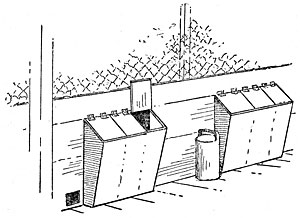
Hoppers reached from alley. For quick feeding and watering openings are made in sides of pens; hoppers and fountains placed over them.
|
Analysis has shown that corn contains more fat-forming elements than wheat. For this reason it became unpopular among poultry feeders. Actual feeding tests, however, show it to be equal to wheat when fed in rational combinations. As good results have been secured in egg production as from wheat. It is, however, an imperfect feed and other feeds must be used to balance it. Those states which produce the largest quantities of corn are the greatest producers of poultry and eggs, a fact which seems to disprove the notion that corn is not good for poultry.
Oats are not relished by fowls as much as other grains, nor are they worth as much as corn or wheat. The large proportion of hull is an objection since hulls are largely indigestible. Without the hulls, oats would be excellent both for laying and fattening. They are not as fattening as corn or wheat and many poultrymen feed them, largely to prevent hens becoming too fat. Great care should be used in selecting oats because of the quality. None but heavy, plump oats should be used. Light oats contain too much hull. Oats furnish a useful variety to the ration. Were hulled oats procurable at reasonable prices, they would probably be better than wheat or corn.
Barley is fed to poultry to a very limited extent. Fowls will usually leave it if they can secure wheat or corn. It may be fed for variety. Peas, where they can be secured at reasonable prices, should be fed extensively because of their richness in protein. They contain twice as much protein as corn and therefore are worth more pound for pound. Where linseed meal can be secured at reasonable prices, it may be profitably fed to poultry because it contains more than 30% protein and is also rich in fat. On this account it is an excellent addition to mash feeds, but must be fed sparingly.
Importance of Animal Feeds
It is believed that animal food of some sort is necessary to maintain fowls in vigorous health and productivity, whether the aim be flesh or eggs. Probably no one thing has done more to increase profits than feeding animal food. Scarcity of eggs during winter is largely due to deficiency in this line. Chickens when at liberty during the summer secure abundant animal food in the form of bugs and worms. Something to take the place of this feed is necessary, especially when snow is on the ground. Doubtless lean meat is the best form to feed. It furnishes ample protein. The presence of a little fat does no harm, but may be an advantage. Fresh meat scrap from the butcher's is an excellent egg maker. Butchers often keep bone cutters to sell ground meat and bones to poultrymen. When flocks of 25 hens or more are kept it will then pay to own a bone cutter. These butcher scraps contain large quantities of bone, which the fowls eat very greedily along with the meat. Much of the mineral matter for making shell and other parts of the ash of the egg may be secured through bone.
Skim milk is a good substitute for animal feed if given liberally, but it is not concentrated enough. It contains about 90 per cent water or only about 10 per cent of food. When used as a drink hens will not take enough of it to supply their demand for animal feed. Milk is well used for mixing the wet mashes, by feeding it clabbered, and best in the form of cottage cheese, which is a particularly good form when well made.
A good way to make cottage cheese is to set the dish of skim milk where the temperature will range between 75 and 80 degrees for 18 to 24 hours, by which time the milk will have thickened. It should then be broken up into pieces about the size of peas or smaller. The dish should then be set in a pail of hot water and the curd stirred until its temperature is 90 or 95, when it should be held at this heat for 15 or 20 minutes without stirring. The contents of the dish should then be poured into a cotton sack and hung up where the whey may drain off. Care must be exercised not to allow the milk to boil. After the whey has drained off a little salt should be added. This cheese will keep in mild weather for a day or two; longer in cool weather.
Doubtless the most convenient form in which to feed animal food is beef scrap, a by-product of the large packing houses. It has been boiled and dried, and as it reaches the poultryman contains meat and bone in varying proportions, but should analyze 50 to 60 per cent protein. It also varies in quality, but should always be light colored, have a meaty flavor and be rather oily to the touch. When boiling water is added to it, it should smell like fresh meat. If a putrid odor is given off it should not be fed.
Green Feed Essential

Green feed free. Thousand-headed kale; hung for hens to peck at.
|
It is essential to the fowls' well being and egg production to have green food every day. Lack is sure to affect egg production unfavorably. Flocks at range can secure abundant green food, but flocks in yards and in winter quarters must be supplied. It may be fed without stint at all times. Among the best feeds are clover, alfalfa, grass, vetches, pea vines, rape, rye, mangels, kale, cabbages, sugar beets, turnips -- in fact anything and everything the hens will eat. During the winter cabbage is specially useful. Root crops are good also. The leaves and broken heads from the hay mow may be steamed if desired. Kale and alfalfa contain especially large amounts of protein and ash. The latter and clover give a good flavor and quality to the eggs; but kale, cabbage, turnip and other plants of the mustard family are likely to impart a slightly disagreeable flavor if fed too abundantly.
According to Prof. J. E. Rice, oats and peas sown together very thinly with a liberal seeding of red clover and a very little rape make a good combination. The oats and peas furnish a rapid growth of green feed. Much of it will get tramped down and some go to seed, but will serve to protect the clover and the rape, which will make good feed late in summer and fall. Three pecks of oats, two of peas, a pound of rape and 5 quarts of red clover seed make a good proportion for sowing an acre. The oats and peas should be first harrowed in deeply, then the clover and rape sown mixed and lightly scratched in with a weeder. The potatoes may be fed for variety boiled and mixed with a mash, but they are not very useful as an egg food. They do better for fattening. Sour apples should not be fed unless sparingly.
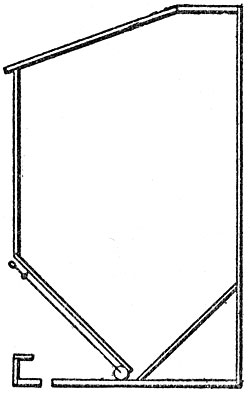
Grit or shell hopper. Hole in floor is for dust to drop through.
|
Necessity for Grit
At all times chickens need grit. Opinions differ as to the function of grit. One view is that grit is to grind the food; the other is that grit itself is a food. It is not necessary to argue on this point, but it is necessary to supply the grit. Fowls at liberty usually pick up enough grit except where the land is deficient in sand and gravel. When confined they must have a liberal supply. When gravel is close by the grit question is easily answered. Plenty of sharp sand for the hens to scratch in is all that is necessary. Where gravel is scarce grit must be purchased. It is very cheap. Besides ordinary grit, it is desirable to supply other material for forming the egg shells. Grain does not contain sufficient lime for great egg layers. Oyster and other sea shells are largely used for this purpose, since they are very readily dissolved in the gizzard. Lack of lime or other shell material in the ration often leads to the egg-eating habit among hens, because soft-shelled eggs are laid and broken in the nest.
Charcoal is believed to be useful as a bowel regulator. Most successful poultrymen keep it constantly before the hens. Salt in moderation aids digestion. An ounce or two daily is sufficient for 100 hens. Pepper, which acts as a stimulant, should be fed sparingly. Vigorous hens do not need it.
The following table prepared by Prof. James Dryden, of the Oregon agricultural college, gives five rations for laying fowls:
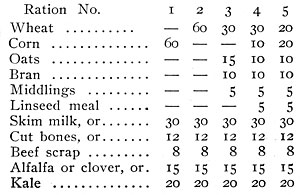
No. 1 is considered the poorest and No. 5 the best. Corn is the only grain fed in No. 1; wheat in No. 2. This ration is placed ahead of No. 1, because it contains some more protein. Both are deficient in egg-making material, viz.: protein. Either would be an improvement on the average farm ration, but neither is ideal. No. 3, which contains a variety of grains and somewhat more protein, is better than the first two. Nos. 4 and 5 should give abundance of eggs if properly fed. They do not equal the amounts of protein, but No. 5 has more meat-producing food.
It is not definitely known to what extent fat influences egg yield, but it has been found that rations containing plenty of fat give better results than rations with little. Since fowls eat more food during cold than during warm weather, heat-producing foods are more necessary and can be made to replace the more expensive protein food to a certain extent. More corn should be fed during winter. On this account No. 5 will be found a better winter ration than No. 4. No. 1 will also probably give better results than No. 2 during the winter.
Next: Chapter 7 Part 2
Back to Index
Back to the Small Farms Library Index
Community development | Rural development
City farms | Organic gardening | Composting | Small farms | Biofuel | Solar box cookers
Trees, soil and water | Seeds of the world | Appropriate technology | Project vehicles
Home | What people are saying about us | About Handmade Projects
Projects | Internet | Schools projects | Sitemap | Site Search | Donations |

